I played around to see if I can figure it out. Here three points that might bring you closer to a canonical answer on why there's a different behavior between physical connections (thermal, in your case) and signal connections (Real input/output, in your case):
Real input/output are causal, and declared differently than physical connectors
connector RealInput = input Real "'input Real' as connector" annotation (...);
connector PhysConnector
Real pt;
flow Real flw;
annotation (...);
end PhysConnector;
Real input/output look more like functions than connectors. I suppose the rule The array dimensions of the connected arrays of connectors must match does not apply/is not enforced for them. I can think of different reasons for this; two of them could be:
- There's a general accepted framework to deal with tables, the same way the majority of us agree that looking at a geographical map the top-left corner is north-west. So the connections are sorted automatically according to the sequence: 1st dim, 2nd dim, 3rd dim,... Multidimensional physical connections on the other hand might represent all sorts of scenarios. Better leave the model designer the responsibility to build it up correctly
- Real input/output generate one assignment instead of a set of equations, therefore they don't mess up too much with the sorting algorithms when figuring out the causality of the system
I tried eventually to test a standard connector with only a potential variable, to see if the problem was due to the two equations generated when also a flow variable is present. The flat Modelica shows there's only one equation generated (as expected), but still the connection matrix[:,:],array[:].array[:] is not allowed.
package MultidimConnections
connector RealConnector
Real r;
annotation(Icon(coordinateSystem(preserveAspectRatio=false)),Diagram(coordinateSystem(preserveAspectRatio=false)));
end RealConnector;
partial model RealInterface
RealConnector realConnector annotation(Placement(transformation(extent={{90,-10},{110,10}})));
annotation(Icon(coordinateSystem(preserveAspectRatio=false),graphics={Rectangle(extent={{-100,100},{100,-100}},lineColor={28,108,200},fillColor={170,213,255},fillPattern=FillPattern.None)}),Diagram(coordinateSystem(preserveAspectRatio=false)));
end RealInterface;
model Source
extends RealInterface;
parameter Real k = 0;
equation
k = realConnector.r;
annotation(Icon(coordinateSystem(preserveAspectRatio=false),graphics={Rectangle(extent={{-80,80},{80,-60}},lineColor={28,108,200},fillColor={151,226,75},fillPattern=FillPattern.Solid), Text(extent={{-100,-60},{100,-100}},lineColor={28,108,200},fillColor={151,226,75},fillPattern=FillPattern.Solid,textString="%name")}),Diagram(coordinateSystem(preserveAspectRatio=false)));
end Source;
model User
extends RealInterface;
Real double;
equation
double = 2*realConnector.r;
annotation(Icon(coordinateSystem(preserveAspectRatio=false), graphics={Rectangle(extent={{-80,80},{80,-60}},lineColor={28,108,200},fillColor={85,170,255},fillPattern=FillPattern.Solid), Text(extent={{-100,-60},{100,-100}},lineColor={28,108,200},fillColor={85,170,255},fillPattern=FillPattern.Solid,textString="%name")}),Diagram(coordinateSystem(preserveAspectRatio=false)));
end User;
model User_multi
MultidimConnections.User user annotation(Placement(transformation(extent={{-10,40},{10,60}})));
MultidimConnections.User user1 annotation(Placement(transformation(extent={{-10,-10},{10,10}})));
MultidimConnections.User user2 annotation(Placement(transformation(extent={{-10,-60},{10,-40}})));
RealConnector realConnector[3] annotation(Placement(transformation(extent={{110,-10},{90,10}})));
equation
connect(user.realConnector, realConnector[1]) annotation(Line(points={{10,50},{98,50},{98,-6.66667},{100,-6.66667}}, color={0,0,0}));
connect(user1.realConnector, realConnector[2]) annotation(Line(points={{10,0},{98,0},{98,4.44089e-16},{100,4.44089e-16}}, color={0,0,0}));
connect(user2.realConnector, realConnector[3]) annotation(Line(points={{10,-50},{98,-50},{98,6.66667},{100,6.66667}}, color={0,0,0}));
annotation(Icon(coordinateSystem(preserveAspectRatio=false), graphics={Rectangle(extent={{-80,80},{80,40}},lineColor={28,108,200},fillColor={85,170,255},fillPattern=FillPattern.Solid),Text(extent={{-100,-60},{100,-100}},lineColor={28,108,200},fillColor={85,170,255},fillPattern=FillPattern.Solid,textString="%name"),Rectangle(extent={{-80,28},{80,-12}},lineColor={28,108,200},fillColor={85,170,255},fillPattern=FillPattern.Solid),Rectangle(extent={{-80,-20},{80,-60}},lineColor={28,108,200},fillColor={85,170,255},fillPattern=FillPattern.Solid),Rectangle(extent={{-100,100},{100,-102}}, lineColor={28,108,200})}),Diagram(coordinateSystem(preserveAspectRatio=false)));
end User_multi;
model TestCustomReal
extends Modelica.Icons.Example;
Source source(k=1) annotation(Placement(transformation(extent={{-60,40},{-40,60}})));
User user annotation(Placement(transformation(extent={{60,40},{40,60}})));
User_multi user_multi annotation(Placement(transformation(extent={{60,-10},{40,10}})));
Source source_arr[3](k=1) annotation(Placement(transformation(extent={{-60,-10},{-40,10}})));
User_multi user_multi_array[3] annotation(Placement(transformation(extent={{60,-60},{40,-40}})));
Source source_mat[3,3](k=1) annotation(Placement(transformation(extent={{-60,-60},{-40,-40}})));
equation
connect(source.realConnector, user.realConnector) annotation(Line(points={{-40,50},{40,50}}, color={0,0,0}));
connect(source_arr.realConnector, user_multi.realConnector) annotation(Line(points={{-40,0},{40,0}}, color={0,0,0}));
connect(source_mat.realConnector, user_multi_array.realConnector) annotation(Line(points={{-40,-50},{40,-50}}, color={0,0,0}));
end TestCustomReal;
annotation(uses(Modelica(version="3.2.3")));
end MultidimConnections;

